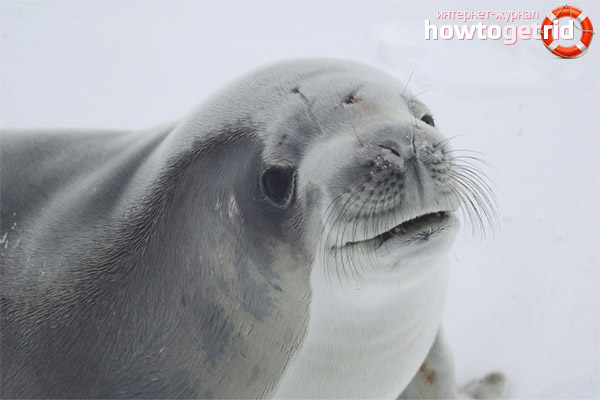The content of the article
Today, the crabeater seal is the most numerous representative of its kind. According to recent studies, the number of this mammal is about 15 million individuals, which is an impressive figure for such a large animal. The seal occupies an honorable third place in terms of numbers after humans and domestic animals. Moreover, the crab eater is several times higher than the number of all other seals combined. Surprisingly, the name of the animal does not reflect the actual state of affairs, and the sea animal does not feed on crabs at all. The seal received its name in some European languages. Not without the help of a pun in Russian, the animal turned out to be a crab-eater. In fact, the basis of the diet of this large mammal is krill - an arthropod from the class of higher cancers. What is a crabeater seal, what it looks like, where it lives and what it eats, let's try to figure it out.
Appearance of the crabeater seal
The size of the average individual of the crabeater seal is 2-2.5 meters, and the weight often exceeds two centners. Females are slightly larger than males, individual representatives of this species can weigh 300 kg or more. The color of the seal fur can vary from gray to brown, depending on the age of the individual and season. At the end of winter and the beginning of spring, molting takes place, as a result of which individuals acquire a new coat - dark brown on the back and light gray in the abdomen. Old seals are lighter, almost whitish, even with new hair. By the end of the season, the brown color of all seals fades, individuals acquire a pleasant cream shade. Newborn crab eaters have a soft coat with a nice gray color and brown blotches. In general, despite the enormous size and colossal weight, seals look quite graceful and harmonious, their body is elongated, their muzzle is narrow and neat.
Crabeater Seal Habitat
Crab eaters live in the marginal seas of Antarctica, often migrate behind drifting ice. The main condition for the life of seals is the availability of food. In summer, seals can often be found off the coast; in autumn, animals move along the path of large ice flows. Crab eaters often move with large ice at least three meters thick. Geographically, you can meet a mammal in New Zealand, Australia, South America.
Crabeater Seal Lifestyle
Crabeater lives in numerous colonies, some of which number more than one hundred thousand individuals. Seals arrange rookeries right on the ice, animals are able to jump out of the water even to the steepest shore. With the help of peculiar jumps and rolls, crab eaters skillfully move on slippery ice.Seals feel excellent in water - they are graceful and swift hunters. Food is obtained mainly at night - the main diet is not only krill, but also all kinds of fish.
Between January and March, the mating season begins at the seals. The carrying of the calves by crab eaters lasts about 9 months, so the couple is almost immediately after the birth of the baby. That is, a female with a cub and a male form the so-called triad, which is not typical for other species of seals. After the baby is born, the mother feeds it with milk for several more weeks, during which the puppies actively gain weight, often increasing it by 4 or more times. At birth, seals weigh about 30 kg, and their body size is about a meter. Each day, the cub gains almost 4 kg, and by the end of milk feeding its weight is more than 100 kg.
In the late 19th and early 20th centuries, a British scientist and participant in Antarctic expeditions suggested an interesting fact - crabeater seals swim away to die inland, away from the coastline. Conclusions were made on the basis of the found remains of seals at a distance of almost 50 km from the coast. Examination of the remains showed that they all died a natural death. This gives reason to believe that animals have a sufficiently high intelligence, this makes the world of crabeater seal even more interesting and fascinating.











Submit